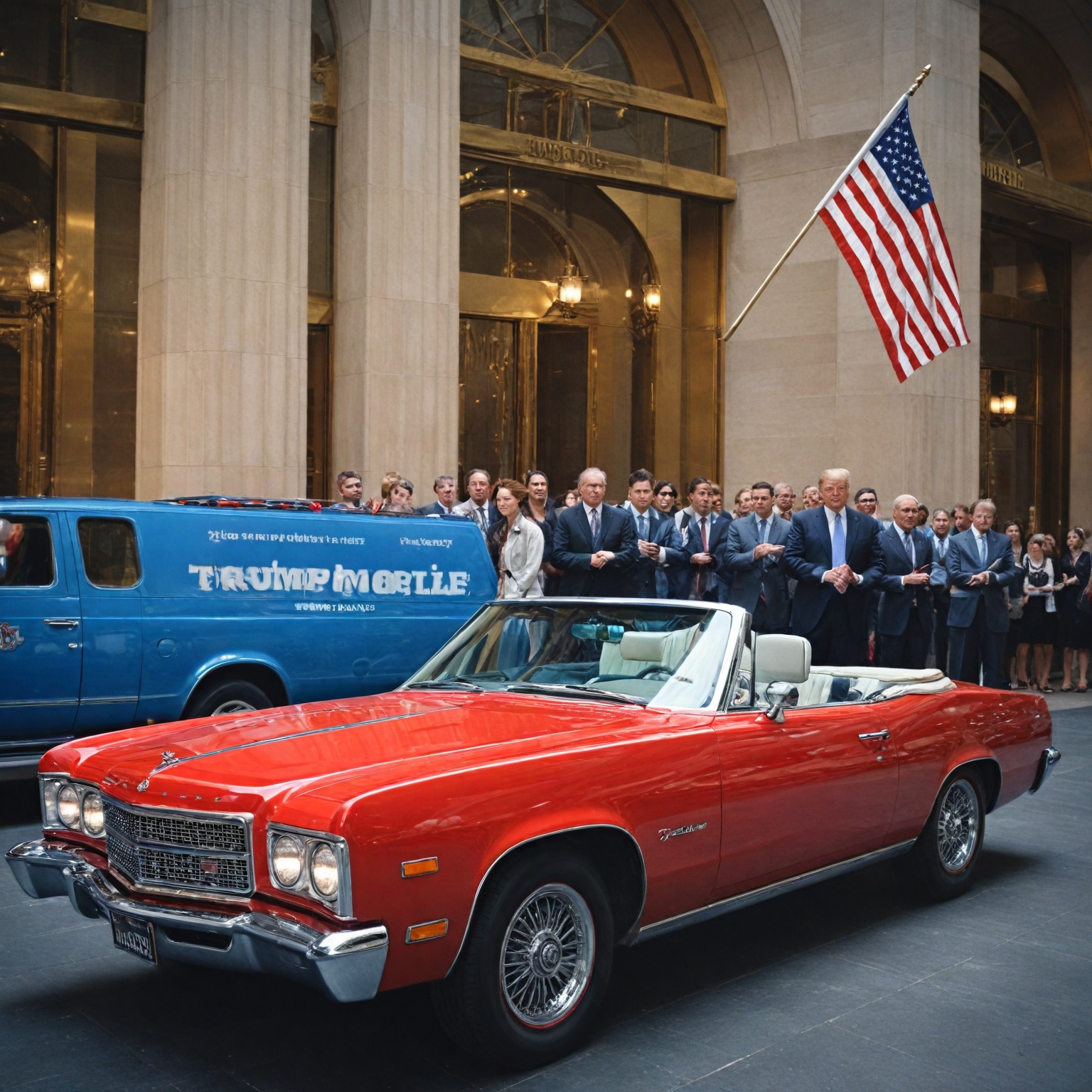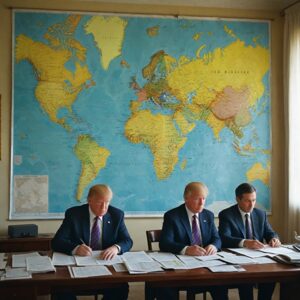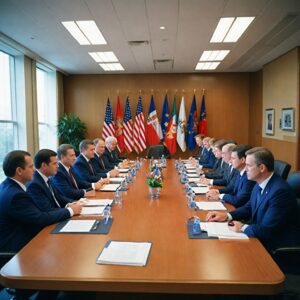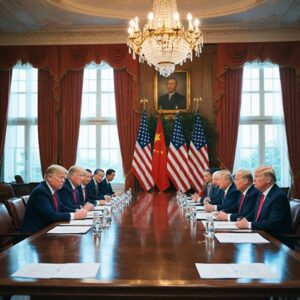Summary
The Trump Organization, a diversified American conglomerate owned by former President Donald Trump, launched a new telecommunications venture in 2024 called Trump Mobile, marking its entry into the highly competitive U.S. wireless market. The service offers a distinctive mobile plan featuring a $499 flagship smartphone, branded as the T1, alongside a subscription priced at approximately $47.45 per month. Trump Mobile positions itself as a patriotic alternative to the dominant national carriers—Verizon, AT&T, and T-Mobile—emphasizing American-made devices and U.S.-based customer support to appeal primarily to conservative consumers seeking domestic products and services.
Operating as a mobile virtual network operator (MVNO), Trump Mobile provides 5G coverage through existing major networks while bundling traditional cellular service with additional features such as telemedicine access, roadside assistance, and international texting to over 100 countries. The introduction of the Trump-branded smartphone and mobile service represents a strategic effort by the Trump Organization to leverage its brand recognition and political influence to carve out a niche in a market dominated by a few large incumbents controlling over 95% of wireless subscribers in the United States.
Despite its bold entry, the venture has faced skepticism from industry observers due to the challenges inherent in the U.S. telecom market, including high manufacturing costs, complex supply chains, and regulatory scrutiny. The Trump Organization’s emphasis on domestic manufacturing and customer service highlights a broader political and ideological alignment intended to differentiate the brand, though media coverage and public reception have been mixed and relatively muted outside of company communications.
Trump Mobile’s launch also intersects with ongoing debates about market consolidation and regulatory policy in the telecommunications sector, where shifts toward deregulation under the Trump administration could influence competition and consumer choice. The success of the new mobile plan is closely tied to Donald Trump’s personal brand and its resonance with a target demographic, making it a notable example of the convergence between business strategy and political identity in contemporary American commerce.
Background
The Trump Organization, Inc. is an American conglomerate privately owned by Donald Trump, serving as the holding company for most of his business ventures and investments, with around 250 affiliates and subsidiaries bearing the Trump name. Traditionally known for its real estate and hospitality businesses, the organization has recently diversified into new sectors, including digital media and cryptocurrency.
In line with this diversification, the Trump Organization launched a self-branded mobile service called Trump Mobile in June 2024. This move represents an effort to target conservative consumers by positioning the service as an alternative to the major U.S. telecom providers—Verizon, AT&T, and T-Mobile—which dominate over 95% of the wireless market. Trump Mobile is distinguished by its U.S.-based call centers and American-made phones, including a flagship $499 smartphone, underscoring a focus on domestic production despite the broader industry’s reliance on overseas component sourcing.
The introduction of Trump Mobile marks the latest attempt by the Trump family to expand its portfolio beyond its traditional industries and leverage the brand’s political and cultural influence to capture a niche market segment. This strategic move reflects a broader trend of aligning business ventures with the political and ideological preferences of a specific consumer base.
Development and Announcement of the New Mobile Plan
The Trump Organization announced a new mobile venture featuring a Trump-branded smartphone and a subscription-based mobile plan. This initiative was unveiled at Trump Tower in New York, with Donald Trump Jr. highlighting the comprehensive nature of the offering. The mobile plan promises an all-in-one package including telemedicine services accessible via the phone for a flat monthly fee, roadside assistance for vehicles, and unlimited texting to over 100 countries worldwide. The smartphone was slated to become available starting in September, accompanied by a monthly subscription priced at $47.45.
The announcement emphasized that the call centers supporting the service would be based in the United States, and the phones themselves would be manufactured domestically. This aligns with the organization’s broader messaging around American-made products and services. Following the launch, a dedicated website was activated providing detailed information about the new mobile service and the associated hardware.
The New Mobile Plan
The Trump Organization has launched a new mobile service branded as Trump Mobile, which aims to position itself as a competitive alternative to the major U.S. telecom providers. The service offers 5G coverage through all three leading wireless networks—AT&T, Verizon, and T-Mobile—allowing customers to benefit from extensive nationwide connectivity. Unlike many competitors, Trump Mobile emphasizes a fully U.S.-based customer service operation, with call centers staffed domestically and available 24 hours a day, ensuring that customers “talk to a real person” when they call.
A key feature of the new mobile plan is its bundled offerings, which extend beyond traditional cellular service. The package includes telemedicine access via mobile devices for a flat monthly fee, roadside assistance for vehicles, and unlimited texting to 100 countries worldwide. These added services aim to differentiate Trump Mobile in a crowded market by integrating lifestyle and utility benefits into a single plan.
Accompanying the service launch is the introduction of the T1 smartphone, Trump Mobile’s proprietary device, which is slated for release in September 2025. This device is part of the organization’s effort to support American-made products, addressing concerns about the current lack of significant domestic smartphone manufacturing due to high labor costs and complex supply chains.
The flagship subscription plan is priced at approximately $47.45 per month, presenting a competitive option for consumers seeking flexible, affordable service with extensive network access and value-added features. By leveraging existing infrastructure from major carriers, Trump Mobile operates as a Mobile Virtual Network Operator (MVNO), which allows it to offer these services without the capital-intensive burden of building its own wireless network.
The $499 Smartphone
The Trump Organization announced the launch of a new smartphone priced at $499, scheduled to be available starting in September. The device, branded as the “T1” smartphone, features a distinctive design highlighted by a gold-colored metal case etched with an American flag, emphasizing its patriotic branding.
The smartphone will be sold alongside a subscription plan costing $47.45 per month, which is part of the new mobile network service offered by the Trump Organization. This entry into the highly saturated and competitive U.S. smartphone market comes at a time when the industry is dominated by global giants such as Apple and Samsung. Despite the prominence of these brands, the United States lacks significant domestic smartphone manufacturing infrastructure, primarily due to high labor costs, complex supply chains, and dependence on overseas component sourcing.
The Trump Organization’s filings with the U.S. Patent and Trademark Office cover the use of the Trump name and “T1” branding for telecom-related products and services, including mobile phones, accessories, and wireless telephone services. There is also the possibility of retail outlets being part of the venture.
The launch reflects a strategic move to establish a presence in the mobile network market, which is currently dominated by three national carriers—Verizon, AT&T, and T-Mobile—that collectively control over 95% of wireless subscribers in the U.S.. The Trump-branded smartphone and accompanying network service represent an attempt to carve out a niche within this highly consolidated and capital-intensive market.
Marketing and Positioning
The Trump Organization’s new mobile plan enters an already saturated and highly competitive U.S. smartphone market, dominated by major global brands like Apple and Samsung, as well as three national carriers—Verizon, AT&T, and T-Mobile—that collectively control over 95% of the wireless market. Positioned amidst this landscape, the Trump Organization has filed trademark applications to use President Trump’s name and the term “T1” for a variety of telecom-related services, including mobile phones, accessories, wireless telephone services, and possibly retail outlets, indicating a broad scope for its marketing efforts.
In contrast to traditional carriers, newer market entrants and smaller operators often leverage mobile virtual network operators (MVNOs) to provide competitive service plans without the heavy investment in network infrastructure. These MVNOs target niche segments and offer both prepaid and postpaid options, increasing consumer choice and driving price competition. The Trump Organization’s strategy could involve similar partnerships or reselling arrangements, which are common in the industry, to capitalize on established networks and reduce operational complexity.
T-Mobile’s disruptive marketing approach, branding itself as the “Un-carrier,” exemplifies how aggressive positioning can differentiate services by eliminating contracts, allowing customers to bring their own devices, and removing overage fees—tactics that have successfully attracted consumers dissatisfied with incumbent providers. The Trump Organization may seek to carve out a unique market position by leveraging the President’s brand recognition, which is noted as a significant asset in driving customer interest and trust.
Moreover, third-party websites and sales agents play a critical role in the current telecom ecosystem by offering exclusive deals, discounted plans, and promotional incentives, which attract certain customer segments beyond direct carrier channels. This suggests that the Trump Organization’s mobile plan might utilize similar distribution channels to enhance visibility and reach.
However, the U.S. mobile telecommunications market faces challenges such as high labor costs, complex supply chains, and a lack of domestic smartphone production infrastructure, which have historically limited the establishment of new manufacturing operations despite strong U.S.-based tech brands. The Trump Organization’s marketing and positioning strategy will need to navigate these structural factors, possibly emphasizing value, branding, and customer experience over hardware innovation.
Reception and Public Response
The announcement of the Trump Organization’s new mobile plan featuring a $4.99 smartphone deal generated a mixed response from the public and industry observers. While official communications emphasized exclusive offers and special announcements tied to the launch, detailed media coverage remained limited. Notably, the deal received virtually no widespread press attention beyond the company’s own releases, with key figures such as company CEO Dan O’Dowd highlighting the importance of technology integrity but the Trump campaign declining to comment.
Industry experts noted that the telecommunications sector’s regulatory environment, shaped by the Federal Communications Commission (FCC), could influence the plan’s market reception. Under the anticipated shift to a more lenient FCC approach toward telecom consolidation and deregulation, the Trump Organization’s initiative was seen as potentially benefiting from reduced regulatory hurdles, although traditional consumer advocacy groups might express skepticism about the long-term impact on market competition and consumer protection.
In addition to regulatory considerations, some analysis pointed to the significance of Donald J. Trump’s reputation and public profile as factors contributing to the venture’s prospects. The success of the new mobile plan was partly linked to the Chairman’s popularity, which could sway consumer interest and brand loyalty amid a competitive telecommunications market.
Strategic Goals and Business Context
The Trump Organization has recently ventured into the telecommunications market with the launch of Trump Mobile, a mobile network service targeting conservative consumers. This new initiative aims to provide an alternative to the major U.S. carriers by emphasizing American-made phones and U.S.-based call centers, aligning with a broader strategy of appealing to a patriotic customer base and expanding the organization’s diversification beyond its traditional real estate holdings.
The strategic goals of Trump Mobile are situated within a challenging market landscape dominated by three national carriers—Verizon, AT&T, and T-Mobile—that together control over 95% of the U.S. wireless market. These incumbents operate extensive, capital-intensive infrastructures and offer bundled services to tens of millions of subscribers. Additionally, the lack of significant domestic smartphone production infrastructure, due to factors such as high labor costs and complex supply chains reliant on overseas components, presents a considerable obstacle for new entrants like Trump Mobile seeking to offer American-made devices.
Despite these challenges, the Trump Organization seeks to position Trump Mobile as a competitive player by leveraging its brand recognition and focusing on service values that resonate with its target demographic. This move represents part of a broader trend of diversification for the Trump family, which has recently expanded into areas such as digital media and cryptocurrency alongside its core real estate businesses.
In this context, the introduction of a smartphone deal priced at $499 and the emphasis on all-American service demonstrate the organization’s intent to carve out a niche within the U.S. telecommunications market. This strategy must be understood within the highly consolidated industry environment, where mergers and alliances, such as the potential T-Mobile and Sprint merger, continue to reshape competitive dynamics. The Trump Organization’s initiative aims to disrupt this landscape by offering differentiated value propositions tied to brand identity and consumer loyalty.
Impact and Significance
The unveiling of the new mobile plan by the Trump Organization, featuring a $4.99 smartphone deal, carries notable implications for the U.S. telecommunications market and broader regulatory environment. Given that the success of the merged company partly depends on the reputation and popularity of its Chairman, President Donald J. Trump, his personal brand adds a unique dimension to the venture’s potential influence.
The U.S. mobile network market is currently dominated by three national carriers—Verizon, AT&T, and T-Mobile—that together control over 95% of the wireless market. This market concentration raises questions about competition, pricing, and consumer choice, especially in light of ongoing discussions about further wireless carrier consolidation. For example, previous regulatory perspectives, such as those from the British regulator Ofcom, emphasize the consumer benefits of maintaining multiple credible national wholesalers to promote better services and lower prices. In this context, the Trump Organization’s entry with an aggressive pricing strategy could potentially disrupt existing market dynamics.
Furthermore, the regulatory landscape under the Trump administration is expected to be more favorable toward mergers and acquisitions (M&A), potentially facilitating smoother approval processes for deals like those involving Dish and Direct TV. This shift signals a strategic pivot toward reducing regulatory barriers and aligning with presidential objectives, which may impact how telecommunications companies plan their business operations and competitive strategies. The Federal Communications Commission (FCC) and Federal Trade Commission (FTC) may impose fewer conditions on transactions, accelerating consolidation trends and altering the competitive balance in the industry.


























